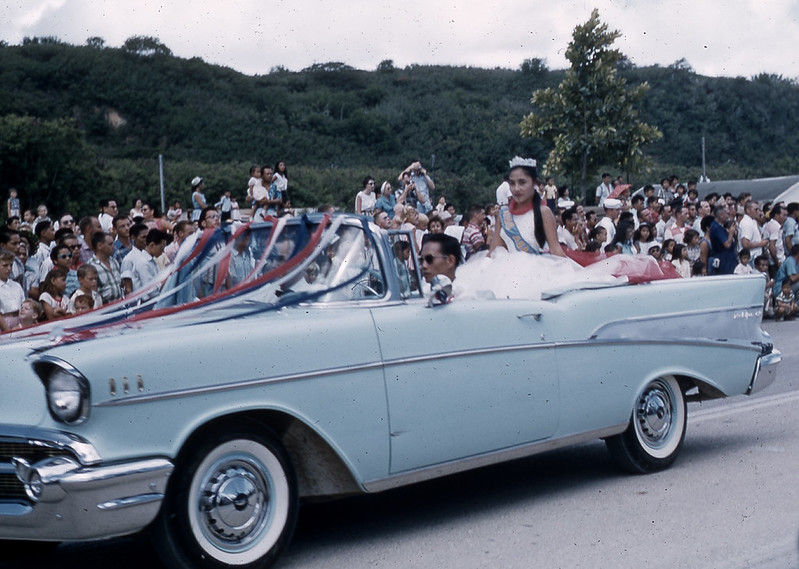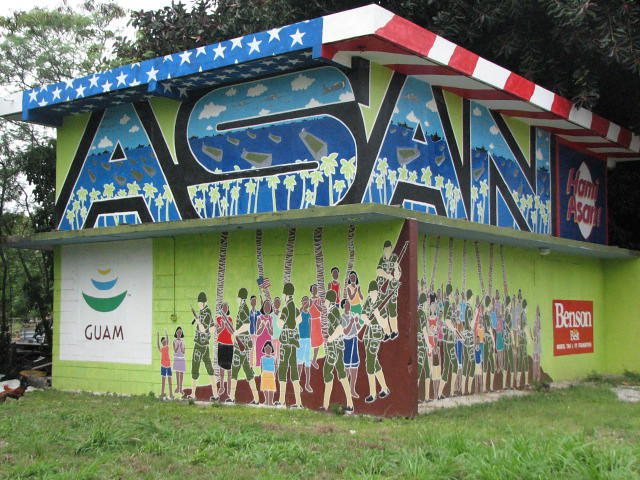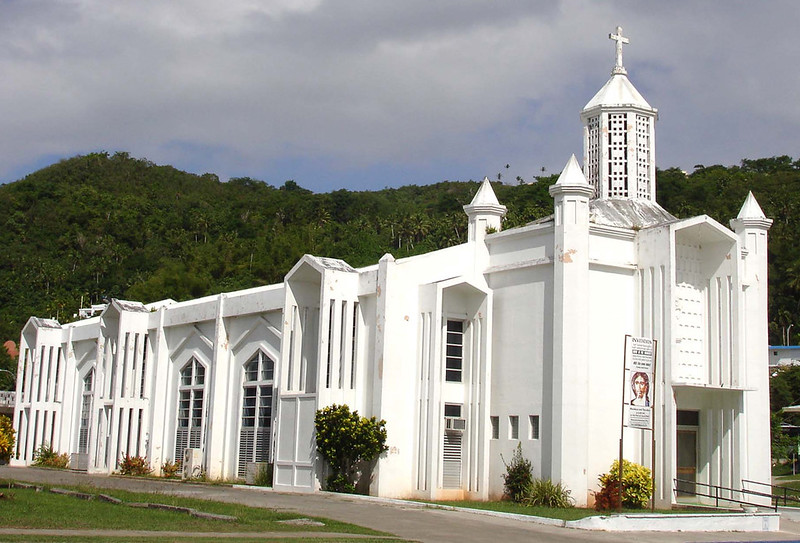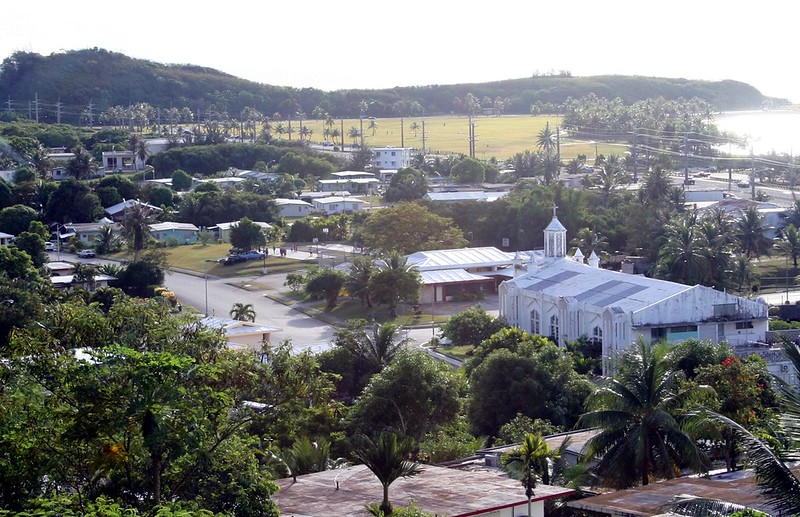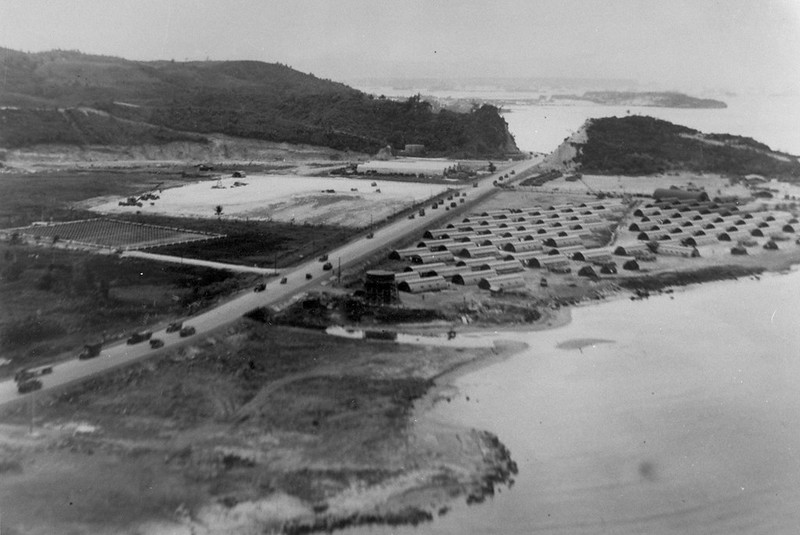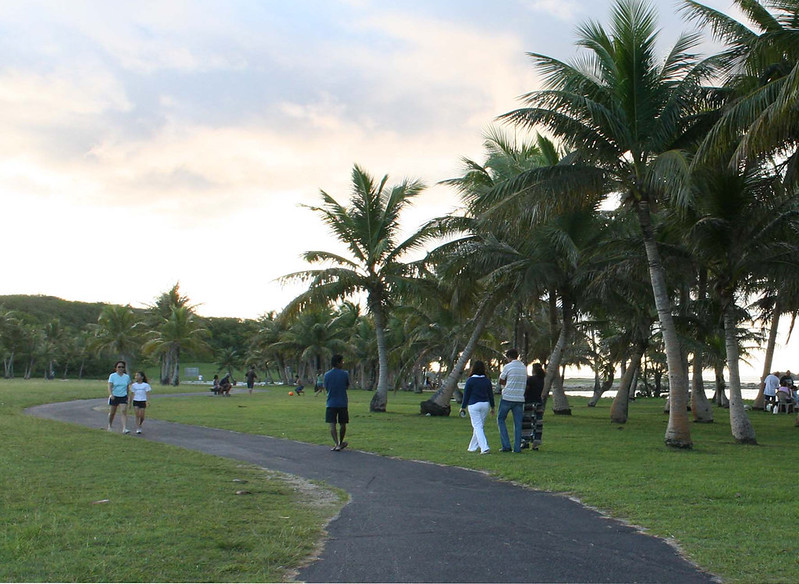Asan-Maina (Assan-Ma’ina)
Origin of village name in CHamoru
The village of Asan probably derives its name from the word Hassan, which means scarce or rare in CHamoru. There are several theories of the origin of the name of the sub-community of Ma’ina, which comes from the CHamoru word ina (to illuminate or shine on). Some of the variations on the village name’s origin are hunters in the area who hunted by the light of a torch and then saw their prey by the light of that torch; infants brought at sunrise to baptismal masses at which Catholics believe a person receives the “light” of God; and the moon that rises to illuminate the entire valley in which Ma’ina is situated.
Population
As of the 2010 US Census, the population was 2,137.
Village officials
The mayor of Asan-Maina is Frankie A. Salas.
Village description
The district of Asan-Maina encompasses a large area, including the main coastal village of Asan, the community of Maina nestled in a valley between Nimitz Hill and Agana Heights, and most of Nimitz Hill (also known as Libugon), and land beyond it further inland.
The main village of Asan was redeveloped in the 1980s by the Guam Housing and Urban Renewal Authority (GHURA). The redevelopment changed the village’s look from its more traditional Spanish flavor to a fairly modern suburban appearance. The streets were straightened, sidewalks were added, and nearly all houses were built concrete and often two stories high. GHURA still owns many of the houses in the main village, houses that were all built exactly alike, and even painted the same color. Space was limited by the ocean to the west and the hills to the east, which necessitated the two story structures and small yards.
The village sits partly on the hillside of Nimitz Hill and partly on the flat land below it, just in front of the sea. Many of the houses are built on steep roads going up the hillside, reminiscent of San Francisco. The Catholic church, Niño Perdido Y Sagrada Familia (Holy Family), sits at the center of the village, along with the community center and mayor’s office.
Asan’s most distinguishable landmark is a large grassy park that sits between the main village and the ocean. Known by many as Asan Beach Park, the Asan Beach Unit of the War in the Pacific National Historical Park is a large expanse of grass, with coconut trees, pavilions, a popular walking path, the Liberator’s Memorial and historical artifacts commemorating the battle that took place in Asan at the end of World War II.
A separate part of the park is located on Nimitz Hill, called the Asan Bay Overlook, which contains a memorial wall of those who died on Guam during WWII, along with a lookout area with a panoramic view of the area in which the Asan battle took place.
Nimitz Hill, named for US Navy Admiral Chester Nimitz, is also home to the former Naval headquarters, the Top of the Mar restaurant, and a number of very expensive houses built there for the hill’s spectacular view. The navy’s top brass is also housed here.
Maina rests in a valley of lush vegetation, bamboo groves, and colorful flowers that come right up to the houses and the main road. The small community is spread out along one small, winding main road, one end of which meets the road going up Nimitz Hill and twists its way to the back side of Agana Heights. The small Fonte Bridge at the end of the road is the site of the famous Guam legend of the “White Lady.”
The area surrounding the bridge is covered with lush vegetation fed by the nutrient-rich soil near the river. The Fonte Dam (also known as Libugon Dam) was reportedly the first dam built on Guam. It was the main freshwater source for the majority of the island’s population that lived in Hagåtña before World War II.
Village history
The village of Asan was predominantly a fishing village in pre-Spanish times that switched to farming with the settlement of the Spaniards. Villages grew taro, rice, and sugar cane on the fertile flatland between the beach and the hills.
In 1892, Asan beach was the site of a Leper Colony, which was used for eight years until destroyed by a typhoon. Then in 1901, the area was turned into a prison camp for exiled Filipino insurrectionists, including Apolonario Mabini, a leader against the US takeover of the Philippines, who is today considered a Philippine national hero.
In 1917, when the US declared war on Germany, the enlisted men of the German cruiser SMS Cormoran, which had been docked in Apra Harbor for three years, were imprisoned at Asan Point by the naval authorities.
In 1922, Asan Point became a US Marine Corps camp with a quartermaster depot, a small arms range, and barracks, but the area, along with most of the island, was demilitarized in 1931.
During World War II, Asan beach played a vital part in the American recapture of Guam from the occupying Japanese forces. On 21 July 1944, the American invasion took place on the beaches of Asan and Hågat, beginning with a bombardment of the island at 5:30 am Japanese defensive positions were placed on top and on both sides of Asan and Adelup points. The US Armed Forces had four battleships, three cruisers, and three destroyers just off of Asan.
Then at 7 am transports moved toward shore in Asan to unload 180 armored landing vehicles full of assault troops. Lead Marines crossed the reef from 200 to 500 yards offshore and landed on Asan beach, which was defended by Japanese infantry and naval troops manning coastal defense guns.
Nine Marine battalions landed at four points along the coast, assaulted the beaches, took Orote Peninsula, the land behind Asan and Libugon Hill (which was renamed after Nimitz following the war). Fighting lasted several days, with desperate Japanese soldiers making last-ditch “banzai” suicide charges at the Marines. The Asan area was secured on 28 July but it took until 10 August 1944 to eliminate all organized resistance on the rest of Guam.
After World War II ended, Asan Beach became known as Camp Asan until 1947. Camp Asan was used as headquarters and barracks for the US Navy Seabees who helped to reconstruct the island. The village of Asan was relocated further inland along the bottom of the hillside. Maina was also added as part of the municipality.
From 1948 to 1967, Camp Asan became the “Civil Service Camp.” In essence, it was a small military base with housing, an outdoor theater, tennis courts, and a fire station. In 1968, the Navy converted the buildings into a hospital annex for use during the Vietnam War. This was utilized for seven years, until the area was turned into Vietnamese Refugee Camp in 1975. There were a total of 111,000 Vietnamese refugees who came through Guam after the Fall of Saigon.
In 1976, Supertyphoon Pamela destroyed all of the remaining buildings at Asan beach and the area was cleared of the debris by the Navy. The National Park Service acquired the area in 1978 and the War in the Pacific National Historical Park was established.
Points of interest
Village Map
Institutions
Church of Christ
Church of Christ is a Christian Bible church located along Marine Corps Drive in the main village of Asan.
Niño Perdido Y Sagrada Familia (Holy Family Church)
Asan’s Catholic church was established in 1947, just after World War II, and is the center of the main village. Like all other parishes, the village Catholic faithful honor their patron saint with an annual fiesta on the last Sunday of December.
Our Lady of Purification Church
Maina’s Catholic church was also established shortly after World War II in 1949. Parishioners honor their patron saint on the first Sunday of February or the last Sunday in January.
Historical
Asan Bay Overlook
Located on Nimitz Hill contains a memorial wall in honor of 16,142 CHamorus and Americans who died on Guam during the war. Bronze panels illustrate scenes of the invasion, occupation, and liberation of the island. The site provides a beautiful panoramic view of the Asan landing beach.
Fonte Dam
The Fonte Dam (also known as Libugon Dam) was reportedly the first dam built on Guam. It was the main freshwater source for the majority of the island’s population that lived in Hagåtña before World War II.
Asan Beach Unit, War in the Pacific National Historical Park
The Asan Beach Unit is the site of the American northern landing beach in World War II. There are three World War II monuments located in the park – the Marine Monument, Liberator’s Monument and Marine Invasion Plaque. The monument and bust of Apolinario Mabini can also be found in the park along the beachside.
The National Park hosts their annual, “This Flag is For…” for the Memorial Day weekend. On this occasion the grounds are covered with small American and Guam flags symbolizing the lives lost in WWII.
Village mayors/commissioners
The first several mayors of the village were naval governor appointments, until residents were allowed the elect commissioners, and later mayors.
Mayors/Commissioners
- Frankie A. Salas, Mayor, 2017-Present
- Joana Margaret C. Blas, Mayor, 2013-2016
- Vicente L. San Nicolas Commissioner/Mayor 1989-2012
- Francisco A. Acfalle, Commissioner, 1985-1989
- Daniel L. Guerrero, Commissioner, 1981-1984
- Jose S. Quitugua, Commissioner, 1973-1981
- Joaquin S. Santos, Commissioner, 1957-1973
- Santiago A. Limtiaco, Commissioner, 1944-1957
- Joaquin L. Jesus, Commissioner, 1938-1941
- Santiago A. Limtiaco, Commissioner, 1931-1938
- Santiago A. Limtiaco, Commissioner, 1930-
- Enrique S. Cruz Commissioner, 1927-
Vice Mayor/Deputy Commissioner
- Felomeno San Nicolas, Deputy Commissioner, (no date given)
Editor’s note: The preceding list was provided by Konsehelon Mahot Guåhan/the Mayor’s Council of Guam.
For further reading
Mayors Council of Guam. “MCOG – Mayors Council of Guam.”
National Park Service. “War In The Pacific National Historical Park.”
Onedera, Peter R., ed. Nå’an Lugåt Siha gi ya Guåhan (Guam Place Names). Hagåtña: Chamorro Language Commission, 1988.
US Department of the Interior National Park Service. “Cultural Landscapes Inventory (Part 4).” In Asan and Agat Invasion Beaches, War in the Pacific National Historical Park. Hågat: NPS, 2004.
Know my island- Know my history
Legend of the White Lady
The Fonte River is the site of the local “White Lady” legend. According to the legend, a beautiful young maiden died of a broken heart, waiting for her boyfriend to meet her at the bridge.
Another story centers around a grieving mother who also died there as she searched in vain for her child lost in the bamboo grove around the bridge. People driving over the bridge, especially late at night, have claimed to see the ghost of the “White Lady.”
